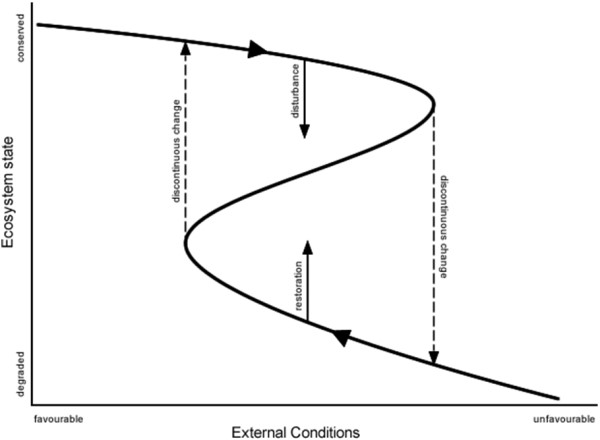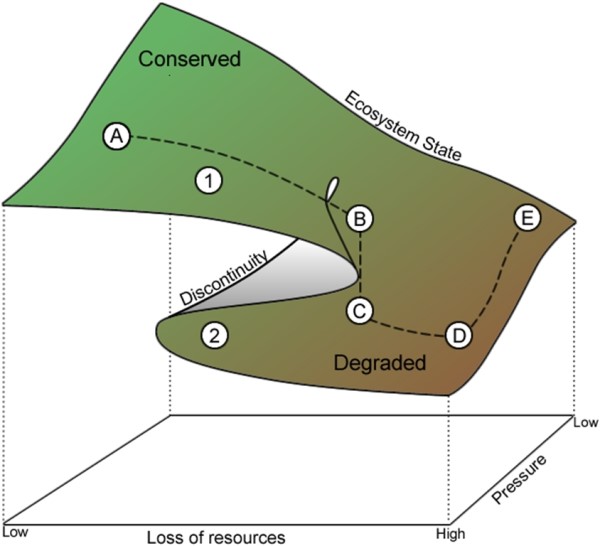| Authors: | Tsanis, I. K. and Daliakopoulos, I. N. |
| Editor: | Jane Brandt |
| Source document: | Daliakopoulos, I. and Tsanis, I. (eds) 2014. Drivers of change in the study sites. CASCADE Project Deliverable 2.2. CASCADE Report 06. 59 pp. |
A generally accepted framework for the description of catastrophic shifts is that of the fold catastrophe. This framework describes the existence of more than one stable state paths of the state of an ecosystem. Assuming that the conserved state of an ecosystem also represents its desirable state, certain disturbances caused by unfavorable external conditions can cause the system to destabilize towards a degraded state. The maximum disturbance that can be absorbed by the system is considered as the system resilience. Knowing the exact magnitude of the system resilience a priory is rather challenging as it usually depends on feedback loops between biotic and abiotic components of the ecosystem.

As long as the disturbance stays within the resilience, the system has the capacity to assume its previous conserved state when external conditions become favorable. When system resilience is exceeded, then the system jumps to a new state through a discontinuous change. This degraded state is also stable in the sense that it also presents a new resilience against external conditions. In many cases, applying extremely favorable conditions (e.g. via a restoration attempt) may not be enough to cause the system to return to the initial desirable state but will instead lead to an alternative situation (not shown). The reason is that the shift from desirable state to alternative state is often accompanied by a loss of resources, and that the restoration attempt might not result in sufficient recovery of these resources to allow a shift back to the original desirable state. This alternative path is a form of system adaptation or an entirely different system which is not always desirable as it may hold inferior ecosystem value than the initial system.
While the above framework explains a one dimensional external input well, ecosystems usually depend on more than one variable and behave in more complex ways. Especially for dryland systems, buffering mechanisms that keep them within certain boundaries are also considered. For example the absence or abundance of a resource may prevent transition to a conserved or degraded state respectively. This dependence of an ecosystem to more than one variables or system states can be depicted with the use of the cusp catastrophe.

In the figure above (A) represents an area where a driver is causing pressure to the ecosystem which nevertheless retains a good status and high resources. Here the system is in stable state 1, and can maintain this state regardless of the grazing pressure due to its resilience. As resources become depleted the system reaches the tipping point (B) where two alternative stable states (1 and 2) can co-exist. The transition between B to C is very quick as processes that take place are exponential. An example is a grazing system where the rate of consumption becomes significantly higher than the rate of biomass production leading to collapse. If resources are depleted further (D), transitioning back to C or B may require some kind of effort, especially when drivers and human induced. More importantly, eliminating the exerted pressure will drive the system to an alternative state E rather than back to its pristine condition. Therefore it is possible that the system becomes “trapped” in this alternative state, especially if resources at hand are non-renewable (e.g. soil) and their loss cannot be amended within a reasonable timeframe (e.g. the human lifespan). Recovery from E may be more gradual as resources are recovered provided pressures are controlled.
The cusp catastrophe concept and variations can be adopted for different ecosystems or selected ecosystem health indicators. For example a grazing system that simultaneously faces overgrazing and depletion of water resources can be driven to prolonged periods of no vegetation cover and eventually to desertification. Similar transitions can take place between different states of a forest where the combined high fire frequency and loss of resources (e.g. seed bank or soil) can lead to changes in the phenology of the vegetation and ultimately to a stable shrubland. This framework explains the relevant stability of natural systems when external (e.g. anthropogenic) pressure is absent or minimal and resources are not depleted. Indeed, in the case of a grazing system the cusp catastrophe model predicts continuous changes of vegetation biomass when e.g. water availability decreases. On the other hand, system resilience (i.e. the magnitude of disturbance the system can absorb) decreases as grazing intensity increases towards overgrazing. In a similar manner, water resources and nutrient depletion may cause continuous changes in the vegetation biomass of a forest as long as the fire frequency remains low. At higher fire frequencies the cusp model predicts a hysteresis.
Beyond the cusp catastrophe theory, the CASCADE Project is carrying out microcosm, mesocosm and landscape experiments that can reveal vegetation interactions at finer scales and possibly common processes across the CASCADE Case Studies. In this context, Remote Sensing derived vegetation indices have a high potential for assessing vegetation activity, as a result of both climatic and human induced drivers.Seasonal vegetation dynamics of NDVI in each Study Site is highly relevant to the seasonal sequence and the perceived length of winter versus the length and severity of summer drought. Therefore, Várzea and Castelsaraceno show higher vegetation activity around the end of spring (May), whereas the rest of the Study Sites have a preference for early spring, when temperatures begin to rise and water availability is still not an issue. Among the Study Sites, by far the poorest vegetation state can be found in Randi Forest, followed by Albatera and Messara. A general conclusion from the analysis of chlorophyll reflectance from satellite imagery is that all Study Sites show only minor trends in the NDVI index, with the exception of Albatera where a strong correlation seems to exist. In »Drivers of change in the study sites we extrapolate from this finding and consider finer scales to derive meaningful correlations.
Fitting Mediterranean instability to the unifying framework
Based on background information collected so far from the CASCADE Study Sites as well as findings on the behavior of ecosystems in response to various pressures, each case is fitted to the cusp catastrophe framework. This step will allow for a common understanding within the CASCADE Project as well as beyond.
In the case of Várzea, pine forest is considered as the desired original state that today exists among eucalyptus plantations. Here the eucalyptus forest cover is relatively stable as it is actively maintained for logging. On the other hand, pine forests are less actively managed and are exposed to forest fire risk. According to the cusp catastrophe framework, a discontinuous change can occur when the frequency of fires incidents reaches a critical level. The critical frequency depends on the time available for seedlings to reach a mature state and produce seeds for the generation that survives the fire. Beyond critical frequency, the pine forest is lost and a stable state of shrubland is established. Depending on land tenure status, restoration attempts in the area may lead to the establishment of additional eucalyptus plantations in place of the pine forest. This path leads to an alternative stable state that offers different ecosystem services compared to the original state. Loss of soil and aridity also play a role in shaping the state of the ecosystem, as shown in the cusp catastrophe model. Present findings show that in the case of Várzea, aridification has already played a significant role, but more importantly, is projected to be a major driver of change in the future. Also, loss of soil here signifies not only the physical loss of material as a consequence of vegetation cover and subsequent wind and water erosion, but also the loss of nutrients and other resources crucial for the soil services provided at the conserved state.
Similar to Várzea, Ayora is facing a transition of the original oak forest to shrub and bare areas due to fire and failed restoration attempts. Here, land is less actively managed than in the case of Várzea, but restoration attempts have pushed towards the establishment of pine forests, possibly as a cost-effective measure. Similar to Várzea, aridification may play a major role against ecosystem recovery, especially under unfavorable climate change scenarios. In the cases of Albaterra and Messara, the original desired state consists of local shrub varieties that contribute various ecosystem services among which fodder for grazing livestock. Grazing intensity, reinforced by loss of soil or water stress gradually lead to a different shrub density or phenology, or even no vegetation cover. In both cases, once system resources have been depleted, restoration attempts lead to an intermediate state that offers ecosystem services inferior to those of the original. Finally, although Castelsaraceno and Randi Forest are located in totally different settings, they both appear to suffer from poor land management and eventually land abandonment that regulate the state of their ecosystems. In the case of Castelsaraceno the system oscillates between different levels of forest encroachment in pastureland, with the desired state being an environment that can sustain grazers. This equilibrium is sensitive, with land abandonment leading to loss of pastures towards shrub and forest and overgrazing leading to bare ground. On the other hand, Randi Forest, now entirely lost, is certainly located in the lower end of the cusp catastrophe model, having lost the required resources to recover to its original state. Land abandonment enables a state of unmanaged grazing that, along with aridity, are highly unfavorable to restoration.
References
For ease of reading, references to other scientific work have been removed from this page. See the full report for details of all the citations
